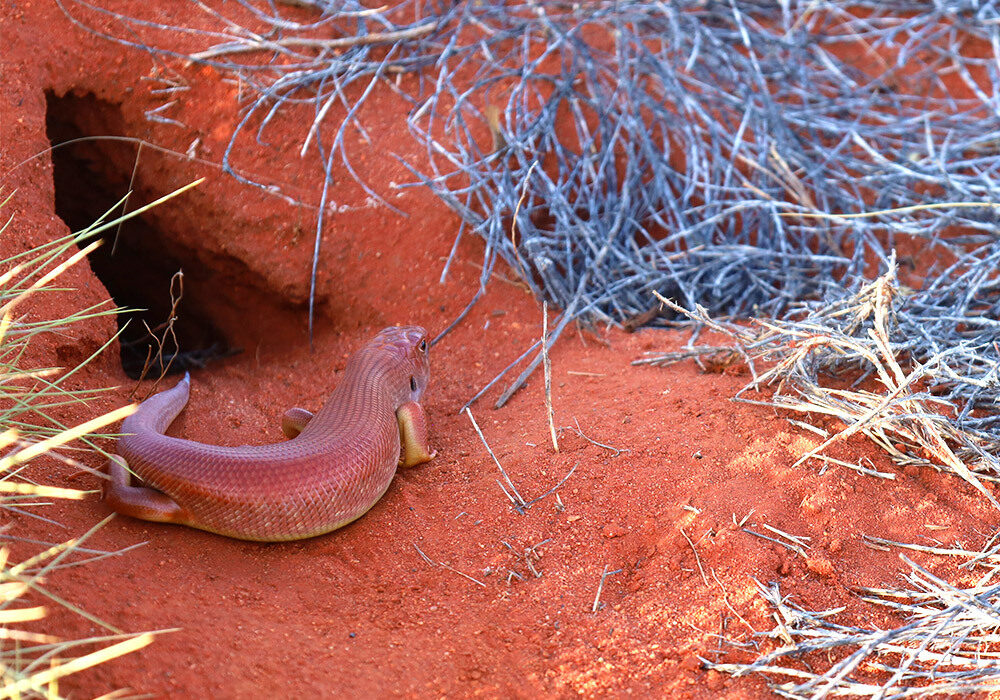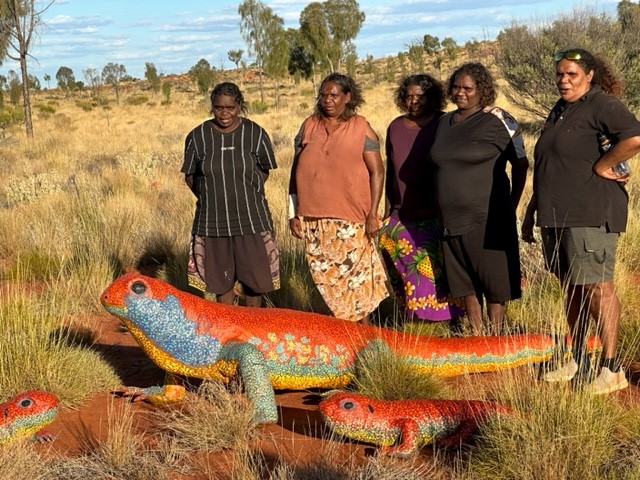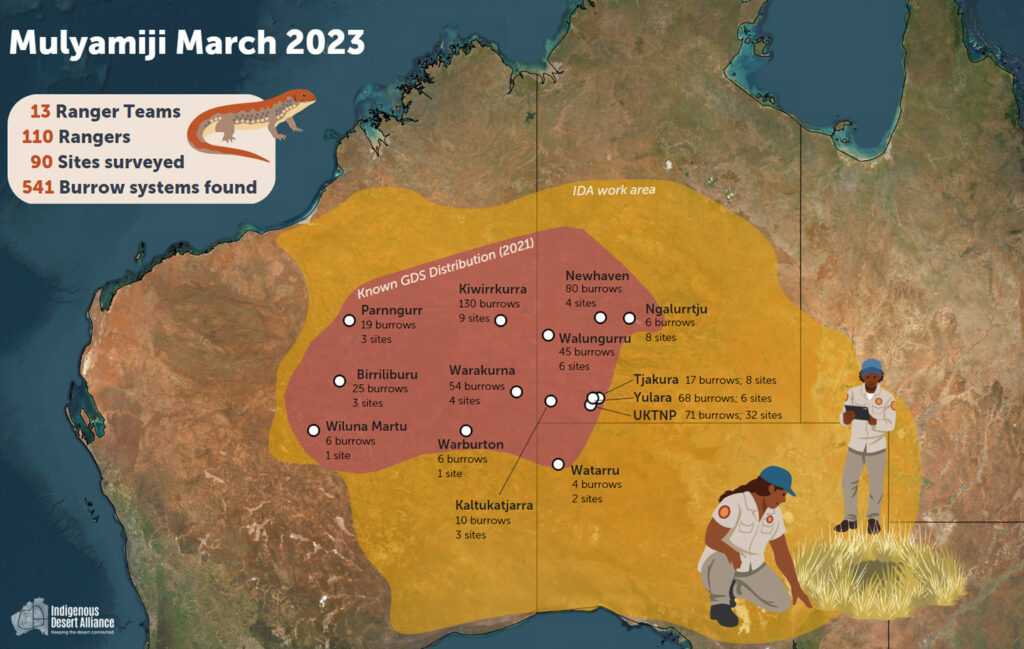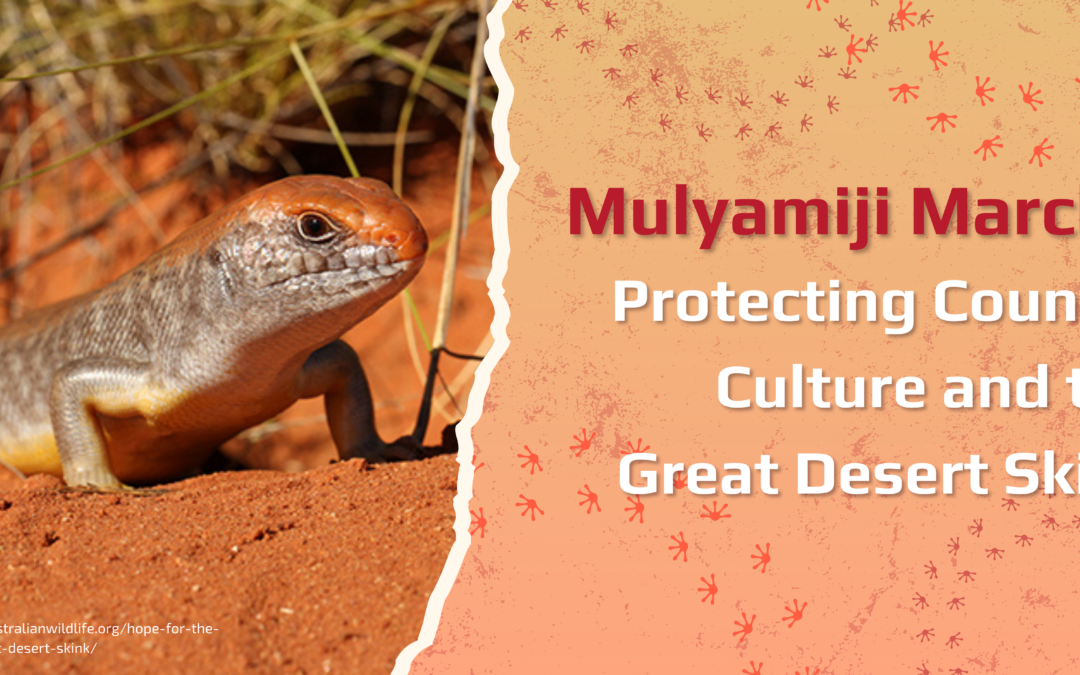While the weather generally starts to cool down in Perth during March, the Western and Central deserts remain hot, and it is time for Mulyamiji March.
Mulyamiji is the Manyjilyjarra name for the Great Desert Skink (Liopholis Kintore); it is a reptile native to the deserts of Western Australia, South Australia and the Northern Territory (DCCEEW, 2024). The species was first listed as vulnerable to extinction under the Environment Protection and Biodiversity Conservation Act 1999 in 2000 and has retained the same classification. While current population numbers are unknown, we know that 20 subpopulations exist, with the highest estimated subpopulation reaching 2000 individuals (DCCEEW, 2023).
To help combat the declining population, Mulyamiji March was introduced under the National Recovery Plan for Great Desert Skink (Liopholis kintorei) (DCCEEW, 2023). Mulyamiji March is an event designed to support Indigenous ranger groups and scientists during the annual monitoring of the Great Desert Skink.

Getting to know the Great Desert Skink
The Great Desert Skink is a large rust-coloured skink (Figure 1) endemic to Australia’s arid western deserts. The species is known for its burrowing and complex interconnected tunnels that may be occupied for years (DCCEEW, 2024). With as many as 20 different entrances, these burrows are shared by family groups, often with up to four generations living in one burrow system (Atlas of Living Australia, 2024).
Growing up to 44cm long and weighing 350g, the Great Desert Skink diet mainly consists of termites. However, they do feed other invertebrates and plants when available. They are also late risers, known to bask near their burrows throughout the morning and afternoon, only venturing out to forage for food at night (DCCEEW, 2024).
March is the ideal time to monitor the species as it falls between the appearance of young adolescent skinks and the beginning of their hibernation period. Great Desert Skinks hibernate between May and June, emerging from hibernation between September and October and birthing young between December and February (DCCEEW, 2024).
The main threats to Mulyamiji are fire and predation by non-native species. Unmanaged fires remove vegetation cover from Mulyamiji burrows, resulting in the burrows becoming inactive within 12 months (DCCEEW, 2023). Burnt burrows can also encourage predation of non-native animals. Effective fire and predator management are goals of the National Recovery Plan (DCCEEW, 2023).
Over the next ten years, Mulyamiji March will support the Great Desert Skink National Recovery Plan by providing essential population data. Monitoring is used to inform management decisions, allowing decision-makers to assess the success of management strategies and address scientific research questions regarding habitat preferences or population responses to fire management.
Indigenous Connection
The Great Desert Skink is a species of cultural importance to many First Nations people across the Desert Region. It has many local names, including Tjakura, Warrarna, Mulyamiji, Nampu, and Aran. Mulyamiji is important to Tjukurpa, or the Dreaming, with its own stories and ceremonies celebrating the animal (DCCEEW, 2023). Tjukurpa is the Aboriginal creation period that conveys the relationships of life and the relationships between people, the land, animals and plants (DCCEEW, 2021).
The Anangu culture of the Yankunytjatjara and Pitjantjatjara people is founded in Tjukurpa (Parks Australia, 2021). Stories, songs and sites of Mulyamiji are shared through Anangu culture, and the Anangu Women’s ranger group spreads cultural knowledge of the animal throughout Mulyamiji March (Figure 2) (Parks Australia, 2021).

Mulyamiji March
As part of the Great Desert Skink National Recovery Plan, the Indigenous Desert Alliance set out to bring together traditional ecological knowledge and scientific knowledge through Mulyamiji March. During March, Aboriginal Ranger teams, scientists and land managers come together to collect data across the deserts of WA, SA, and NT (Figure 3) (Indigenous Desert Alliance, 2023). The first Mulyamiji March occurred in 2023, and the National Recovery team aims to continue Mulyamiji March for the next ten years (DCCEEW, 2023).

Mulyamiji March motivates action across ranger groups and even invites some friendly competition as rangers search sites and burrows. This collaborative event collects valuable data on the current distribution of the species and the number of subpopulations that exist (DCCEEW, 2023). It also identifies the number of sites impacted by fires and predators to inform threat management strategies. Monitoring of the species is an important way of determining if management actions are needed and are benefiting the Mulyamiji population.
Mulyamiji March helps preserve traditional knowledge and culture as information and stories are shared from Elders to the younger generations (Orr, 2023). Supporting on-country trips to Mulyamiji sites, increasing knowledge sharing between rangers and scientists, and assisting with documenting traditional knowledge, songs, and stories keep cultural knowledge alive (DCCEEW, 2023).
If your organisation is working in a region with State and Commonwealth list plants and animal or your business needs to understand the impacts of your activities on Aboriginal culture or heritage values, Integrate Sustainability has a wealth of experience and is able to assist. Please contact us by email at enquiries@integratesustainability.com.au or call us at 08 9468 0338.
References
Atlas of Living Australia. (2024). Liopholis kintorei: Great Desert Skink. Retrieved from Atlas of Living Australia: https://bie.ala.org.au/species/https://biodiversity.org.au/afd/taxa/08ac895d-b350-43d6-8810-65459a59f072
DCCEEW. (2021). Tjukurpa. Retrieved from Department of Climate Change, Energy, the Environment and Water: https://www.dcceew.gov.au/parks-heritage/national-parks/uluru-kata-tjuta-national-park/culture-and-history/tjukurpa
DCCEEW. (2023). National Recovery Plan for the Great Desert Skink (Liopholis kintorei). Retrieved from Department of Climate Change, Energy, the Environment and Water: https://www.dcceew.gov.au/sites/default/files/documents/national-recovery-plan-great-desert-skink.pdf
DCCEEW. (2024). Liopholis kintorei — Great Desert Skink, Tjakura, Warrarna, Mulyamiji, Tjalapa, Nampu. Retrieved from Species Profile and Threats Database: http://www.environment.gov.au/cgi-bin/sprat/public/publicspecies.pl?taxon_id=83160
Indigenous Desert Alliance. (2023). Mulyamiji March. Retrieved from Indigenous Desert Alliance: https://www.indigenousdesertalliance.com/stories/mulyamiji-march
Orr, A. (2023). How working to save a lizard is helping Indigenous rangers reclaim lost knowledge. Retrieved from SBS News: https://www.sbs.com.au/news/article/how-working-to-save-a-lizard-is-helping-indigenous-rangers-reclaim-lost-knowledge/prw0iym94
Parks Australia. (2021). Fact Sheet: Tjukurpa. Retrieved from Uluru-Kata Tjuta National Park: https://parksaustralia.gov.au/uluru/discover/culture/tjukurpa/

